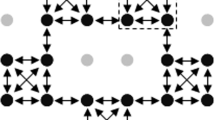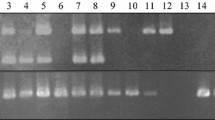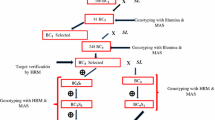Abstract
Pennisetum squamulatum reproduces by apomixis, a type of asexual reproduction through seeds. Apomixis in P. squamulatum is transmitted as a dominant Mendelian trait, and a genomic region, the apospory-specific genomic region (ASGR), is sufficient for inheritance of the trait. The ASGR is physically large (>50 Mb), highly heterochromatic, hemizygous, and recombinationally suppressed. These characteristics have hindered high-resolution genetic mapping and map-based cloning of apomixis genes. In this study, the long terminal repeat (LTR) regions of ASGR-abundant retrotransposons in the genome of P. squamulatum and ASGR-linked bacterial artificial chromosome clones were identified and sequenced for designing LTR-specific primers. Two hundred and ninety single-dose sequence specific amplified polymorphism (SSAP) markers were generated from 38 primer combinations. The SSAP markers combined with two previous ASGR-mapped markers were used for genetic linkage analysis and construction of a genetic map resulting in the formation of 27 linkage groups at LOD 10, one of which contained >60% of the SSAP markers. After removing identical markers (identical band scoring) on the largest linkage group, 46 markers were finally used for genetic mapping at LOD 10. The markers distributed across 10 different loci covering 19 cM; however, 45 markers were distributed within 9 cM. Six markers were recovered and sequenced. Five markers were successfully converted into sequence characterized amplified regions (SCARs). Segregation of SCAR markers was not always consistent with the SSAP markers of origin suggesting a greater level of error in the SSAP map resulting in an inflated map distance for the ASGR. One SCAR marker (Pst 56-1205-400) detected expression of an ASGR retrotransposon in root, anther, leaf and ovary of P. squamulatum, although sequencing of the RT-PCR product failed to find a functional open reading frame for the transcript.






Similar content being viewed by others
References
Acquadro A, Portis E, Moglia A, Magurno F, Lanteri S (2006) Retrotransposon-based S-SAP as a platform for the analysis of genetic variation and linkage in globe artichoke. Genome 49:1149–1159
Ainouche ML, Baumel A, Salmon A, Yannic G (2003) Hybridization, polyploidy and speciation in Spartina (Poaceae). New Phytol 161:165–172
Akiyama Y, Conner JA, Goel S, Morishige DT, Mullet JE, Hanna WW, Ozias-Akins P (2004) High-resolution physical mapping in Pennisetum squamulatum reveals extensive chromosomal heteromorphism of the genomic region associated with apomixis. Plant Physiol 134:1733–1741
Akiyama Y, Hanna WW, Ozias-Akins P (2005) High-resolution physical mapping reveals that the apospory-specific genomic region (ASGR) in Cenchrus ciliaris is located on a heterochromatic and hemizygous region of a single chromosome. Theor Appl Genet 111:1042–1051
Albertini E, Porceddu A, Ferranti F, Reale L, Barcaccia G, Romano B, Falcinelli M (2001) Apospory and parthenogenesis may be uncoupled in Poa pratensis: a cytological investigation. Sex Plant Reprod 14:213–217
Arabidopsis Genome Initiative (2000) Analysis of the genome sequence of the flowering plant Arabidopsis thaliana. Nature 408:796–815
Asker SE, Jerling L (1992) Apomixis in plants. CRC Press, Boca Raton, pp 5–19
Avramova ZV (2002) Heterochromatin in animals and plants. Similarities and differences. Plant Physiol 129:40–49
Berenyi M, Gichuki T, Schmidt J, Burg K (2002) Ty1-copia retrotransposon-based S-SAP (sequence-specific amplified polymorphism) for genetic analysis of sweetpotato. Theor Appl Genet 105:862–869
Bicknell RA, Koltunow AM (2004) Understanding apomixis: recent advances and remaining conundrums. Plant Cell 16(Suppl):S228–S245
Bonin A, Bellemain E, Bronken Eidesen P, Pompanon F, Brochmann C, Taberlet P (2004) How to track and assess genotyping errors in population genetics studies. Mol Ecol 13:3261–3273
Bouck A, Peeler R, Arnold ML, Wessler SR (2005) Genetic mapping of species boundaries in Louisiana irises using IRRE retrotransposon display markers. Genetics 171:1289–1303
Bousios A, Saldana-Oyarzabal I, Valenzuela-Zapata AG, Wood C, Pearce SR (2007) Isolation and characterization of Ty1-copia retrotransposon sequences in the blue agave (Agave tequilana Weber var. azul) and their development as SSAP markers for phylogenetic analysis. Plant Sci 172:291–298
Boyko E, Kalendar R, Korzun V, Fellers J, Korol A, Schulman AH, Gill BS (2002) A high-density cytogenetic map of the Aegilops tauschii genome incorporating retrotransposons and defense-related genes: insights into cereal chromosome structure and function. Plant Mol Biol 48:767–790
Carman JG (1997) Asynchronous expression of duplicate genes in angiosperms may cause apomixis, bispory, tetraspory, and polyembryony. Biol J Linn Soc 61:51–94
Catanach AS, Erasmuson SK, Podivinsky E, Jordan BR, Bicknell R (2006) Deletion mapping of genetic regions associated with apomixis in Hieracium. Proc Natl Acad Sci USA 103:18650–18655
Conner JA, Goel S, Gunawan G, Cordonnier-Pratt M, Johnson VE, Liang C, Wang H, Pratt LH, Mullet JE, DeBarry J, Yang L, Bennetzen JL, Klein PE, Ozias-Akins P (2008) Sequence analysis of BAC clones from the apospory-specific genomic region (ASGR) of Pennisetum and Cenchrus. Plant Physiol 147:1–16
Dooner HK, He L (2008) Maize genome structure variation: interplay between retrotransposon polymorphisms and genic recombination. Plant Cell 20:249–258
Dujardin M, Hanna W (1989) Crossability of pearl millet with wild Pennisetum species. Crop Sci 29:77–80
Ellis TH, Poyser SJ, Knox MR, Vershinin AV, Ambrose MJ (1998) Polymorphism of insertion sites of Ty1-copia class retrotransposons and its use for linkage and diversity analysis in pea. Mol Gen Genet 260:9–19
Flavell AJ, Dunbar E, Anderson R, Pearce SR, Hartley R, Kumar A (1992) Ty1-copia group retrotransposons are ubiquitous and heterogeneous in higher plants. Nucleic Acids Res 20:3639–3644
Flavell AJ, Pearce SR, Heslop-Harrison JS, Kumar A (1997) The evolution of Ty1-copia group retrotransposons in eukaryote genomes. Genetica 100:185–195
Goel S, Chen Z, Conner JA, Akiyama Y, Hanna WW, Ozias-Akins P (2003) Delineation by fluorescence in situ hybridization of a single hemizygous chromosomal region associated with aposporous embryo sac formation in Pennisetum squamulatum and Cenchrus ciliaris. Genetics 163:1069–1082
Goel S, Chen Z, Akiyama Y, Conner JA, Basu M, Gualtieri G, Hanna WW, Ozias-Akins P (2006) Comparative physical mapping of the apospory-specific genomic region in two apomictic grasses: Pennisetum squamulatum and Cenchrus ciliaris. Genetics 173:389–400
Grimanelli D, Leblanc O, De Leon DG, Savidan Y (1995) Apomixis expression in maize-Tripsacum hybrid derivatives and the implications regarding its control and potential for manipulation. Apomixis Newsl 8:35–37
Grimanelli D, Leblanc O, Espinosa E, Perotti E, De Leon DG, Savidan Y (1998) Mapping diplosporous apomixis in tetraploid Tripsacum: one gene or several genes? Heredity 80:33–39
Grimanelli D, Leblanc O, Perotti E, Grossniklaus U (2001) Developmental genetics of gametophytic apomixis. Trends Genet 17:597–604
Grossniklaus U, Nogler GA, van Dijk PJ (2001) How to avoid sex: the genetic control of gametophytic apomixis. Plant Cell 13:1491–1498
Jessup RW, Burson BL, Burow GB, Wang YW, Chang C, Li Z, Paterson AH, Hussey MA (2002) Disomic inheritance, suppressed recombination, and allelic interactions govern apospory in buffelgrass as revealed by genome mapping. Crop Sci 42:1688–1694
Koltunow AM, Bicknell RA, Chaudhury AM (1995) Apomixis: molecular strategies for the generation of genetically identical seeds without fertilization. Plant Physiol 108:1345–1352
Kumar A, Bennetzen JL (1999) Plant retrotransposons. Annu Rev Genet 33:479–532
Kumar A, Hirochika H (2001) Applications of retrotransposons as genetic tools in plant biology. Trends Plant Sci 6:127–134
Labombarda P, Busti A, Caceres ME, Pupilli F, Arcioni S (2002) An AFLP marker tightly linked to apomixis reveals hemizygosity in a portion of the apomixis-controlling locus in Paspalum simplex. Genome 45:513–519
Lightbourn GJ, Jelesko JG, Veilleux RE (2007) Retrotransposon-based markers from potato monoploids used in somatic hybridization. Genome 50:492–501
Liu Z, Wang Y, Shen Y, Guo W, Hao S, Liu B (2004) Extensive alterations in DNA methylation and transcription in rice caused by introgression from Zizania latifolia. Plant Mol Biol 54:571–582
Lou Q, Chen J (2007) Ty1-copia retrotransposon-based SSAP marker development and its potential in the genetic study of cucurbits. Genome 50:802–810
Madsen LH, Fukai E, Radutoiu S, Yost CK, Sandal N, Schauser L, Stougaard J (2005) LORE1, an active low-copy-number TY3-gypsy retrotransposon family in the model legume Lotus japonicus. Plant J 44:372–381
Manninen O, Kalendar R, Robinson J, Schulman AH (2000) Application of BARE-1 retrotransposon markers to the mapping of a major resistance gene for net blotch in barley. Mol Gen Genet 264:325–334
Meeûs T, Prugnolle F, Agnew P (2007) Asexual reproduction: genetics and evolutionary aspects. Cell Mol Life Sci 64:1355–1367
Nogler GA (1984) Gametophytic apomixis. In: Johri BM (ed) Embryology of angiosperms. Springer, Berlin, pp 475–518
Noyes RD, Rieseberg LH (2000) Two independent loci control agamospermy (apomixis) in the triploid flowering plant Erigeron annuus. Genetics 155:379–390
Ozias-Akins P (2006) Apomixis: developmental characteristics and genetics. Crit Rev Plant Sci 25:199–214
Ozias-Akins P, Lubbers EL, Hanna WW, McNay JW (1993) Transmission of the apomictic mode of reproduction in Pennisetum: Co-inheritance of the trait and molecular markers. Theor Appl Genet 85:632–638
Ozias-Akins P, Roche D, Hanna WW (1998) Tight clustering and hemizygosity of apomixis-linked molecular markers in Pennisetum squamulatum implies genetic control of apospory by a divergent locus that may have no allelic form in sexual genotypes. Proc Natl Acad Sci USA 95:5127–5132
Ozias-Akins P, Akiyama Y, Hanna WW (2003) Molecular characterization of the genomic region linked with apomixis in Pennisetum/Cenchrus. Funct Integr Genomics 3:94–104
Panstruga R, Buschges R, Piffanelli P, Schulze-Lefert P (1998) A contiguous 60 kb genomic stretch from barley reveals molecular evidence for gene islands in a monocot genome. Nucleic Acids Res 26:1056–1062
Pearce SR, Stuart-Rogers C, Knox MR, Kumar A, Ellis TH, Flavell AJ (1999) Rapid isolation of plant Ty1-copia group retrotransposon LTR sequences for molecular marker studies. Plant J 19:711–717
Pearce SR, Knox M, Ellis TH, Flavell AJ, Kumar A (2000) Pea Ty1-copia group retrotransposons: transpositional activity and use as markers to study genetic diversity in Pisum. Mol Gen Genet 263:898–907
Pompanon F, Bonin A, Bellemain E, Taberlet P (2005) Genotyping errors: causes, consequences and solutions. Nat Rev Genet 6:847–859
Porceddu A, Albertini E, Barcaccia G, Falcinelli M (2002a) Linkage mapping in apomictic and sexual Kentucky bluegrass (Poa pratensis L.) genotypes using a two-way pseudotestcross strategy based on AFLP and SAMPL markers. Theor Appl Genet 104:273–280
Porceddu A, Albertini E, Barcaccia G, Marconi G, Bertoli FB, Veronesi F (2002b) Development of S-SAP markers based on an LTR-like sequence from Medicago sativa L. Mol Genet Genomics 267:107–114
Queen RA, Gribbon BM, James C, Jack P, Flavell AJ (2004) Retrotransposon-based molecular markers for linkage and genetic diversity analysis in wheat. Mol Genet Genomics 271:91–97
Remington DL, Whetten RW, Liu BH, O’Malley DM (1999) Construction of an AFLP genetic map with nearly complete genome coverage in Pinus taeda. Theor Appl Genet 98:1279–1292
Roche D, Conner J, Budiman A, Frisch D, Wing R, Hanna W, Ozias-Akins P (2002) Construction of BAC libraries from two apomictic grasses to study the microcolinearity of their apospory-specific genomic regions. Theor Appl Genet 104:804–812
Sambrook J, Russell DW (2001) Molecular cloning, 3rd edn. Cold Spring Harbor Laboratory Press, New York
Sant VJ, Sainani MN, Sami-Subbu R, Ranjekar PK, Gupta VS (2000) Ty1-copia retrotransposon-like elements in chickpea genome: their identification, distribution and use for diversity analysis. Gene 257:157–166
Sanz AM, Gonzalez SG, Syed NH, Suso MJ, Saldana CC, Flavell AJ (2007) Genetic diversity analysis in Vicia species using retrotransposon-based SSAP markers. Mol Genet Genomics 278:433–441
Schneider A, Walker SA, Poyser S, Sagan M, Ellis TH, Downie JA (1999) Genetic mapping and functional analysis of a nodulation-defective mutant (sym19) of pea (Pisum sativum L.). Mol Gen Genet 262:1–11
Schulman AH, Flavell AJ, Ellis ΤΗN (2004) The application of LTR retrotransposons as molecular markers in plants. In: Miller WJ, Capy P (eds) Mobile genetic elements: protocols and genomic applications. Humana Press, Totowa, pp 145–173
Scott RJ (2007) Polyspermy in apomictic Crataegus: yes and no. New Phytol 173:227–229
Spillane C, Steimer A, Grossniklaus U (2001) Apomixis in agriculture: the quest for clonal seeds. Sex Plant Reprod 14:179–187
Spillane C, Curtis MD, Grossniklaus U (2004) Apomixis technology development—virgin births in farmers’ fields? Nat Biotechnol 22:687–691
Suoniemi A, Tanskanen J, Schulman AH (1998) Gypsy-like retrotransposons are widespread in the plant kingdom. Plant J 13:699–705
Syed NH, Sureshsundar S, Wilkinson MJ, Bhau BS, Cavalcanti JJ, Flavell AJ (2005) Ty1-copia retrotransposon-based SSAP marker development in cashew (Anacardium occidentale L.). Theor Appl Genet 110:1195–1202
Syed NH, Sorensen AP, Antonise R, van de Wiel C, van der Linden CG, vant Westende W, Hooftman DA, den Nijs HC, Flavell AJ (2006) A detailed linkage map of lettuce based on SSAP, AFLP and NBS markers. Theor Appl Genet 112:517–527
Tam SM, Mhiri C, Vogelaar A, Kerkveld M, Pearce SR, Grandbastien MA (2005) Comparative analyses of genetic diversities within tomato and pepper collections detected by retrotransposon-based SSAP, AFLP and SSR. Theor Appl Genet 110:819–831
The Rice Chromosome 10 Sequencing Consortium (2003) In-depth view of structure, activity, and evolution of rice chromosome 10. Science 300:1566–1569
van Dijk PJ, van Damme J (2000) Apomixis technology and the paradox of sex. Trends Plant Sci 5:81–84
van Dijk PJ, Tas IC, Falque M, Bakx-Schotman T (1999) Crosses between sexual and apomictic dandelions (Taraxacum). II. The breakdown of apomixis. Heredity 83:715–721
Van Ooijen JW, Voorrips RE (2001) JoinMap® 3.0, Software for the calculation of genetic linkage maps, 3rd edn. Plant Research International, Wageningen
Venturi S, Dondini L, Donini P, Sansavini S (2006) Retrotransposon characterisation and fingerprinting of apple clones by S-SAP markers. Theor Appl Genet 112:440–444
Vos P, Hogers R, Bleeker M, Reijans M, van de Lee T, Hornes M, Frijters A, Pot J, Peleman J, Kuiper M et al (1995) AFLP: a new technique for DNA fingerprinting. Nucleic Acids Res 23:4407–4414
Voytas DF, Cummings MP, Koniczny A, Ausubel FM, Rodermel SR (1992) Copia-like retrotransposons are ubiquitous among plants. Proc Natl Acad Sci USA 89:7124–7128
Waugh R, McLean K, Flavell AJ, Pearce SR, Kumar A, Thomas BB, Powell W (1997) Genetic distribution of Bare-1-like retrotransposable elements in the barley genome revealed by sequence-specific amplification polymorphisms (S-SAP). Mol Gen Genet 253:687–694
Wu KK, Burnquist W, Sorrells ME, Tew TL, Moore PH, Tanksley SD (1992) The detection and estimation of linkage in polyploids using single-dose restriction fragments. Theor Appl Genet 83:294–300
Young BA, Sherwood RT, Bashaw EC (1979) Cleared-pistil and thick-sectioning techniques for detecting aposporous apomixis in grasses. Can J Bot 57:1668–1672
Yu GX, Wise RP (2000) An anchored AFLP- and retrotransposon-based map of diploid Avena. Genome 43:736–749
Acknowledgments
We thank Dr. Wayne Hanna for providing plant materials and Dr. Ye Chu, Jackie Merriman, Evelyn P. Morgan and Yajuan Zeng for technical help. This work was supported by the National Science Foundation (award no. 0115911).
Author information
Authors and Affiliations
Corresponding author
Additional information
Communicated by D. Hoisington.
Electronic supplementary material
Table S1
Rights and permissions
About this article
Cite this article
Huo, H., Conner, J.A. & Ozias-Akins, P. Genetic mapping of the apospory-specific genomic region in Pennisetum squamulatum using retrotransposon-based molecular markers. Theor Appl Genet 119, 199–212 (2009). https://doi.org/10.1007/s00122-009-1029-y
Received:
Accepted:
Published:
Issue Date:
DOI: https://doi.org/10.1007/s00122-009-1029-y




